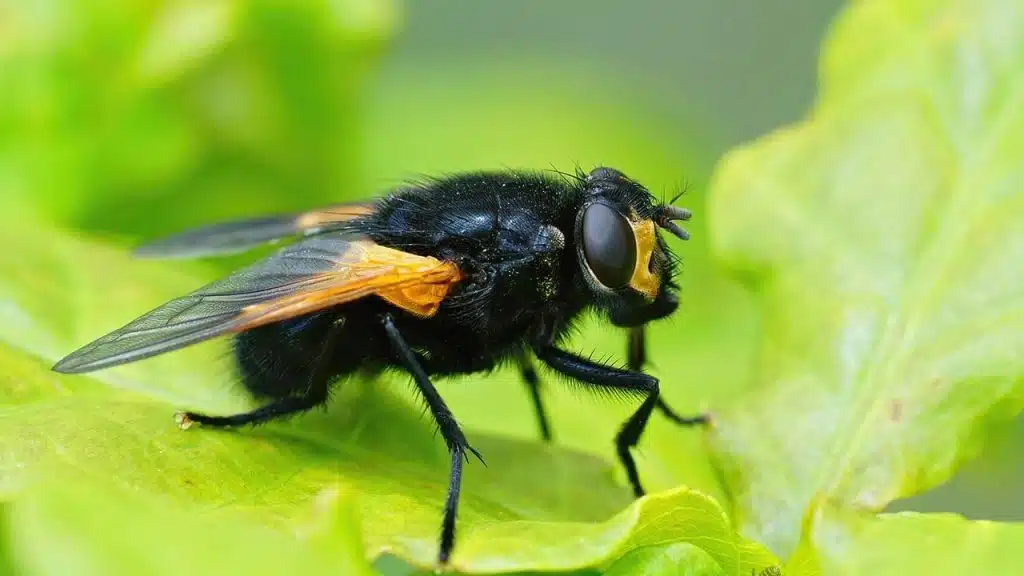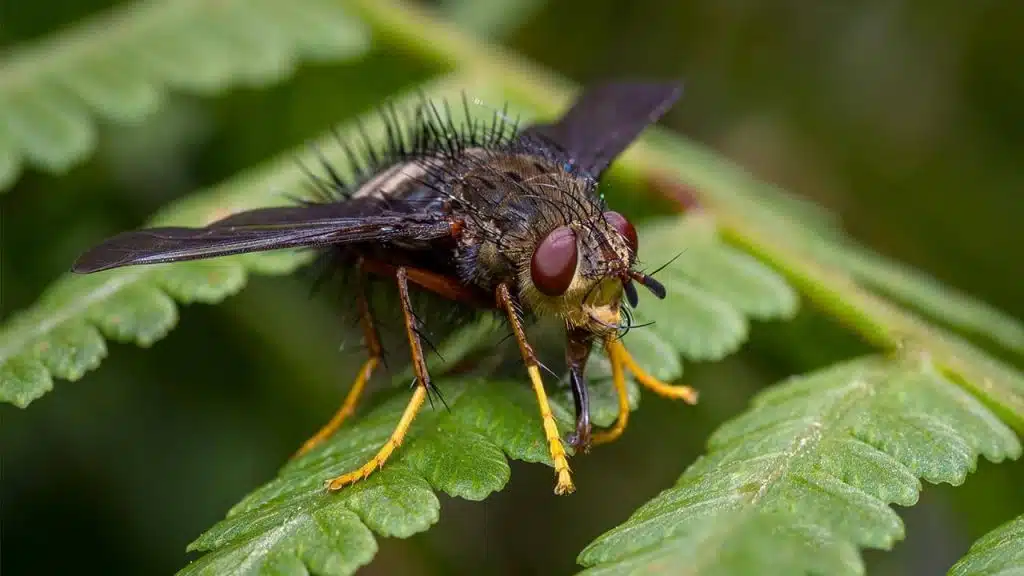

Flies are small buzzing insects that often bother us in our home and at picnic. They belong to a group known as Diptera. It generally means two wings. You can find flie almost everywhere in the world. From busy city to quite forest.
Flies bug us and can make us sick. It’s important to deal with them fast. This guide shares facts about flie and ways to keep them away.
Flies mainly go through 4 stages of their life cycle. They are egg, larva, pupa and adult.
Flies are bugs that bother us a lot. They are small and fly around our homes, gardens, and food. There are many kinds of flie with different behaviors. We will learn about House Flie, Fruit Flie, Blow Flie, and Syrphid Flie.
House flie are common flie found in homes and businesses. They are gray with stripes. Flie like garbage and can spread diseases. Keep your place clean to avoid them.
Fruit flie are tiny bugs that like to hang out near old fruits and veggies. They lay eggs on the fruit and their babies eat the yucky stuff. This can be a problem in kitchens and stores because they make food dirty. To stop them, keep fruits and veggies in the right place, clean the kitchen, and throw away old fruit quickly.
Blow flie are shiny blue or green flies that like dead animals. They help break down dead things by eating them. Blow flies smell bad and like warm places outside. They bother people when there are many of them. To stop blow flie, clean up dead animals and close garbage cans tight.
Syrphid flie are like bees but they don’t sting. They have yellow and black stripes. They help in pollinating flowers by feeding on nectar and pollen. Syrphid flie eat aphids and other pests, helping gardeners. To attract them, plant flowers with nectar.
Flies have special features that help them survive. Their big complex eyes let them see in every direction at once. It makes hard to catch them. That is why catching a flie can be tricky.
Flie have unique mouthparts too. They cannot chew the solid food. So, they spit up digestive fluid onto the food. The food then tun into liquid and then they suck up. This allows them to eat many kinds of food form sweet nectar to decaying matter.
One downside of files is that they can spared diseases. Because they land on garbage, feces and other decaying mater. Thus, they pick up germs. When they land on our food or surface, they can leave germs behind. This can make us sick.

To keep flies out of your home, try these tips:
Stay clean: Always try to dispose the garbage regularly and clean the areas where food is made or eaten. Make sure to clean up pet’s waste. This reduces their breeding site and source of food.
Cover food and waste: Stoor food in airtight container and use trash can with a cover. This prevents flie from accessing potential food source.
Use Screens: Put screens on windows and doors to keep out flie. This is very effective way to keep them out without using chemical. Make sure the screens are in good condition without any holes or tears.
Use Traps: Fly traps both homes made or commercial can capture flies. There are various types of fly traps including sticky traps, electric fly zapper and baited traps that capture or kill them.
Despite their reputation as pests flies play a vital role in environment. As natural decomposer they help break down organic matter result in returning vital nutrients to the soil. This process is crucial for maintaining healthy eco system. Some species of flie also help in pollination helping the reproduction of many plants.
Flies also serve as food source for many animals. They are including birds, frogs, spider and other insects. Their presence supports bio diversity and helps maintaining the balance of various eco system.
Diverse Species: There are more than 120,000 species of flie. Each of them adapted to different environment and life cycle. Some of them are very small while other are large.
Rapid Reproduction: Flie reproduce quickly. Under certain conditions a single pair of flie can lay thousands of eggs in just a few weeks. This rapid reproduction rate helps them to quickly colonize new area.
Short Lifespan: While individual flie have very short life span. Typically ranging from a few days to a couple of weeks. Their ability to reproduce quickly ensure that their population remain stable.
High Speed Flight: flie are capable of flying at speeds up to 5 miles per hour. Their rapid flight pattern helps them to avoid predators and help them to find food.
Flies are bugs that help nature by pollinating plants and being food for animals.
Flie may not be as famous as bees for pollination, but they are proficient at transferring pollen from one plant to another. Certain species of flies are attracted to flowers for their nectar, aiding in the pollination process and contributing to the reproduction of various plant species.
Flie help make old plants and animals into food for new plants. This makes the soil healthy for plants to grow.
Flie are important food for many animals like birds and frogs. They help keep the balance in nature.
Dirty places make flie come. Flies like dirty spots with food. Keep clean to stop flie. Follow these sanitation tips:
Make sure your home is clean and no leftover food is lying around.
Don’t forget to empty and clean the trash cans to stop flie from coming.
Put pet waste in a bag and close it well before throwing it away.
Close any holes or cracks to keep flie out of your house.
Biological control uses bugs that eat flie to help reduce their numbers. It’s a natural way to stop flie without chemicals. Some ways include:
Bring tiny bugs to eat baby flies.
Keep animal places clean for beetle friends.
Put up bird feeders for fly-catching birds.
When flie are everywhere, we can use special sprays to get rid of them. But we must be careful and only use these sprays when nothing else works. Let’s see how they work:
Use bug sprays to kill adult flie.
Spray surfaces to get rid of flie.
Try fogging to control flie indoors.
Traps and baits catch flies. They are safe and not harmful. You can use them inside and outside. Here are some traps and baits:
Sticky traps catch flie with sticky surface.
UV light traps lure flie with light.
Bait stations attract flie to feed on it.

Flie are bugs that people don’t know much about. Learning the truth can help us understand them better.
Flie don’t like light. They follow smell and movement, not light.
Flie bug us but don’t live long. They usually live for about 21 days.
Learn new ways to stop flies. Find better solutions for pest control. Use friendly bugs to keep pests away.
Good bugs can help control bad bugs in gardens.
Scientists are studying special flie to have fewer babies and manage their numbers.
Choose ways to stop flie that don’t hurt nature.
Flies are more than just annoying insects that buzz around our heads. They are important part of the nature. They contribute to decomposing organic matter and serving as food source for other animals. While their ability to spread disease makes them unwelcome guests in our home. Understanding their life cycle and ecological roles can help us appreciate their place in nature.
Flies rub their legs together to clean off dust and debris. This also helps to clean their sensor on legs and feet. They are important for detecting food and mates.
Most of the adults’ flies live about 15-30 days depending on circumstance. Their entire life cycle from egg to adult usually in 7 to 10 days depending on optimal conditions.
Yes, flies can spread over 10 germs including bacteria and viruses. They pick up those germs from garbage they land on. Then they fly to human food and cause food poisoning or dysentery.
Flies are attracted to food, garbage, pet waste and standing water. Rotting organic matter such as compost or dead plants also attract Flies at home.
Always maintain cleanliness by disposing of garbage. Make sure to cover the food source. Use a tight container to store food. Cover trash bin and install screens on windows and doors to reduce fly.